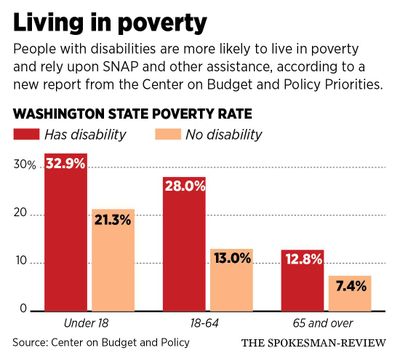This column reflects the opinion of the writer. Learn about the differences between a news story and an opinion column.
Shawn Vestal: The current political zeal for cutting poverty programs will leave millions of vulnerable children and adults hungry

Every month, more than 16,000 households in Spokane County receive federal help buying food.
Most are single-parent families with children, receiving an average benefit of $1.33 per person for every meal. Almost half have a family member with a disability. And all of them have reason to be concerned about the ideas currently in vogue in Washington, D.C.
The president’s budget would significantly cut the Supplemental Nutrition Assistance Program, farming out 25 percent of it to states. That budget is unlikely to ever see the light of day, but it documents the values of the people who made it. In the House of Representatives, meanwhile, there is a strong likelihood that past proposals to cut SNAP benefits and shift responsibility to the states will arise again.
In other words, if the Capitol circus ever turns productive, there is an excellent chance that SNAP benefits – which many of us think of as “food stamps” – will suffer in the name of “reform.”
“When they talk about reform, what they’re talking about is shifting costs” to states, said Julie Watts, deputy director of the Washington State Budget & Policy Center, a liberal think tank. “States would either have to come up with the money or cut benefits.”
This would be a lousy development for many reasons. SNAP is one of the best-designed safety net programs there is: A USDA report noted in 2015 that it effectively targets the neediest people, directing the large majority of help toward the people who demonstrate they need it the most. It’s means-tested, and payments are made on a sliding scale. It has relatively small overhead of 8 percent administrative costs, according to the Government Accountability Office, and an estimated rate of fraud of about 1 percent, according to the USDA.
Crucially, it lifts millions and millions of families above the poverty line. And that protection is particularly important for people with disabilities, a new report from the Center on Budget and Policy Priorities shows.
The report details the degree to which disability and poverty are intertwined: People with disabilities tend to have lower incomes and higher expenses, and are more likely to live in poverty than the overall population.
One paper from the National Bureau of Economic Research estimates that a person with a chronic, severe disability will see a 76 percent drop in earnings over a 10-year period. A study of “material hardship” among households with a disabled family member showed they are far more likely to postpone medical care, run out of food, have no access to a telephone or go without dental care than the population at large.
For the disabled population, the report says, SNAP benefits provide a crucial lifeline.
GOP efforts targeting SNAP – or any safety-net program, from health care insurance to housing assistance – aren’t a surprise. Conservatives argue that SNAP enrollments and costs have remained too high since the recession, that too many able-bodied adults receive the benefits without stringent enough work requirements, and that an overgenerous “welfare state” is discouraging people from going to work by providing “lucrative entitlements,” as the National Review put it in a piece last year.
The Cato Institute, a libertarian think tank, produced a report in 2013 calling the program “deeply troubled” and focusing on the 11 percent of recipients who are adults without kids.
“The program increasingly breeds greater dependence on government,” the report said. “SNAP is no longer a program targeted at the poorest Americans who may need some temporary help, but it has become part of an ever-growing permanent welfare state.”
This paranoid vision of the costly dangers of helping people is ascendant in Congress and the White House. It underlies efforts to undo Obamacare and replace it with something that provides much less to many more. Watts said that changes in the health care and Medicaid systems are likely to be hardest on the disabled, as well – making SNAP benefits an even more important lifeline.
Almost 70 percent of SNAP beneficiaries are in families with children. More than 1 in 4 are seniors or people with a disability; the average per-person benefit is $120 per month. And, while SNAP spending did rise dramatically after the economy crashed in 2007, with caseloads rising from 37 million to 51 million by 2013, they have begun declining again.
Watts said the economic recovery has been weak in terms of jobs, and that is reflected in the SNAP caseloads. The Center on Budget and Policy Priorities predicts caseloads further declining in the years to come.
Still, look for food stamps on the chopping block. The notion of turning the safety net over to states is often sold in terms of providing flexibility and encouraging innovation.
But the true goal is not to make it work better. It’s to shrink it.
If 25 percent of Washington’s SNAP caseload were taken over by the state, that would represent $363 million distributed to 126,000 people.
Imagine how that would fare in Olympia’s budgetary firing squad.
“Not only would this do harm to people with disabilities, to children, to people who are elderly, it would also put the state of Washington on the hook for huge costs,” Watts said. “States are not asking for ‘flexibility,’ because states know that means cost-shifting.”
